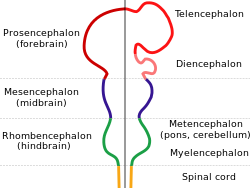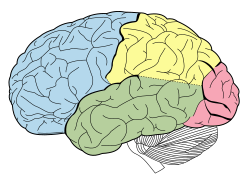Thecerebrum(pl.:cerebra),telencephalonorendbrain[1]is the largest part of thebrain,containing thecerebral cortex(of the twocerebral hemispheres) as well as several subcortical structures, including thehippocampus,basal ganglia,andolfactory bulb.In thehuman brain,the cerebrum is the uppermost region of thecentral nervous system.The cerebrumdevelops prenatallyfrom theforebrain(prosencephalon). In mammals, thedorsaltelencephalon, orpallium,develops into the cerebral cortex, and theventraltelencephalon, orsubpallium,becomes thebasal ganglia.The cerebrum is also divided into approximately symmetricleft and right cerebral hemispheres.
| Cerebrum | |
|---|---|
The lobes of the cerebral cortex include thefrontal(blue),temporal(green),occipital(red), andparietal(yellow) lobes. Thecerebellum(unlabeled) is not part of the telencephalon. | |
 Diagram depicting the main subdivisions of the embryonic vertebrate brain. | |
| Details | |
| Pronunciation | /ˈsɛrɪbrəm/,/sɪˈriːbrəm/ |
| Artery | Anterior cerebral,middle cerebral,posterior cerebral |
| Vein | Cerebral veins |
| Identifiers | |
| Latin | cerebrum |
| MeSH | D054022 |
| NeuroLexID | birnlex_1042 |
| TA98 | A14.1.03.008 A14.1.09.001 |
| TA2 | 5416 |
| TH | H3.11.03.6.00001 |
| TE | E5.14.1.0.2.0.12 |
| FMA | 62000 |
| Anatomical terms of neuroanatomy | |
With the assistance of thecerebellum,the cerebrum controls all voluntary actions in the human body.
Structure
editThe cerebrum is the largest part of thebrain.Depending upon the position of the animal, it lies either in front or on top of thebrainstem.In humans, the cerebrum is the largest and best-developed of the five major divisions of the brain.
The cerebrum is made up of the two cerebral hemispheres and theircerebral cortices(the outer layers ofgrey matter), and the underlying regions ofwhite matter.[2]Its subcortical structures include the hippocampus, basal ganglia and olfactory bulb. The cerebrum consists of two C-shaped cerebral hemispheres, separated from each other by a deep fissure called thelongitudinal fissure.
Cerebral cortex
editThecerebral cortex,the outer layer of grey matter of the cerebrum, is found only in mammals. In larger mammals, including humans, the surface of the cerebral cortex folds to creategyri(ridges) andsulci(furrows) which increase thesurface area.[3]
The cerebral cortex is generally classified into fourlobes:thefrontal,parietal,occipitalandtemporallobes. The lobes are classified based on their overlyingneurocranial bones.[4]A smaller lobe is theinsular lobe,a part of the cerebral cortex folded deep within thelateral sulcusthat separates the temporal lobe from the parietal and frontal lobes, is located within each hemisphere of the mammalian brain.
Cerebral hemispheres
editThe cerebrum is divided by themedial longitudinal fissureinto twocerebral hemispheres,the right and the left. Thecerebrum is contralaterally organized,i.e., the right hemisphere controls and processes signals (predominantly) from the left side of the body, while the left hemisphere controls and processes signals (predominantly) from the right side of the body.[4]According to current knowledge, this is due to anaxial twist that occurs in the early embryo.[5]There is a strong but not completebilateral symmetrybetween the hemispheres, while lateralization tends to increase with increasing brain size.[6]Thelateralization of brain functionlooks at the known and possible differences between the two.
Development
editIn the developing vertebrateembryo,theneural tubeis subdivided into four unseparated sections which then develop further into distinct regions of thecentral nervous system;these are theprosencephalon(forebrain), themesencephalon(midbrain) therhombencephalon(hindbrain) and thespinal cord.[7]The prosencephalon develops further into thetelencephalonand thediencephalon.The dorsal telencephalon gives rise to the pallium (cerebral cortex in mammals and reptiles) and the ventral telencephalon generates thebasal ganglia.The diencephalon develops into thethalamusandhypothalamus,including theoptic vesicles(futureretina).[8]The dorsal telencephalon then forms two lateral telencephalic vesicles, separated by the midline, which develop into the left and right cerebral hemispheres. Birds and fish have a dorsal telencephalon, like all vertebrates, but it is generally unlayered and therefore not considered a cerebral cortex. Only a layered cytoarchitecture can be considered a cortex.
Functions
editNote:As the cerebrum is a gross division with many subdivisions and sub-regions, it is important to state that this section lists only functions that the cerebrumas a wholeserves. (See main articles on cerebral cortex andbasal gangliafor more information.) The cerebrum is a major part of the brain, controlling emotions, hearing, vision, personality and much more. It controls all precision of voluntary actions.
Upper motor neuronsin the primary motor cortex send theiraxonsto the brainstem and spinal cord tosynapseon thelower motor neurons,which innervate the muscles. Damage to motor areas of the cortex can lead to certain types ofmotor neuron disease.This kind of damage results in loss of muscular power and precision rather than totalparalysis.
It functions as the center of sensory perception, memory, thoughts and judgement; the cerebrum also functions as the center of voluntary motor activities.
Sensory processing
editThe primary sensory areas of the cerebral cortex receive and processvisual,auditory,somatosensory,gustatory,andolfactoryinformation. Together with association cortical areas, these brain regions synthesize sensory information into our perceptions of the world.
Olfaction
editTheolfactory bulb,responsible for the sense of smell, takes up a large area of the cerebrum in most vertebrates. However, in humans, this part of the brain is much smaller and lies underneath the frontal lobe. The olfactory sensory system is unique since the neurons in the olfactory bulb send their axons directly to theolfactory cortex,rather than to thethalamusfirst. Olfaction is also the only sense that is represented by the ipsilateral side of the brain. Damage to the olfactory bulb results in a loss of olfaction (the sense of smell).
Language and communication
editSpeechand language are mainly attributed to parts of the cerebral cortex. Motor portions of language are attributed toBroca's areawithin the frontal lobe. Speech comprehension is attributed toWernicke's area,at the temporal-parietal lobe junction. These two regions are interconnected by a largewhite mattertract, thearcuate fasciculus.Damage to the Broca's area results inexpressive aphasia(non-fluent aphasia) while damage to Wernicke's area results inreceptive aphasia(also called fluent aphasia).
Learning and memory
editExplicit or declarative (factual) memory formation is attributed to thehippocampusand associated regions of themedial temporal lobe.This association was originally described after a patient known asHMhad both his left and right hippocampus surgically removed to treat chronic [temporal lobe epilepsy]. After surgery, HM hadanterograde amnesia,or the inability to form new memories.
Implicit orprocedural memory,such as complex motor behaviors, involves the basal ganglia.
Short-term or working memory involves association areas of the cortex, especially thedorsolateral prefrontal cortex,as well as the hippocampus.
Other animals
editIn the most primitive vertebrates, thehagfishesandlampreys,the cerebrum is a relatively simple structure receivingnerve impulsesfrom theolfactory bulb.Incartilaginousandlobe-finned fishesand also inamphibians,a more complex structure is present, with the cerebrum being divided into three distinct regions. The lowermost (or ventral) region forms thebasal nuclei,and contains fibres connecting the rest of the cerebrum to the thalamus. Above this, and forming the lateral part of the cerebrum, is thepaleopallium,while the uppermost (or dorsal) part is referred to as thearchipallium.The cerebrum remains largely devoted to olfactory sensation in these animals, in contrast to its much wider range of functions inamniotes.[9]
Inray-finned fishes,the structure is somewhat different. The inner surfaces of the lateral and ventral regions of the cerebrum bulge up into theventricles;these include both the basal nuclei and the various parts of the pallium and may be complex in structure, especially inteleosts.The dorsal surface of the cerebrum is membranous, and does not contain anynervous tissue.[9]
In the amniotes, the cerebrum becomes increasingly large and complex. Inreptiles,the paleopallium is much larger than in amphibians and its growth has pushed the basal nuclei into the central regions of the cerebrum. As in the lower vertebrates, the grey matter is generally located beneath thewhite matter,but in some reptiles, it spreads out to the surface to form a primitive cortex, especially in the anterior part of the brain.[9]
Inmammals,this development proceeds further, so that the cortex covers almost the whole of the cerebral hemispheres, especially in more developed species, such as theprimates.The paleopallium is pushed to the ventral surface of the brain, where it becomes the olfactory lobes, while the archipallium becomes rolled over at the medial dorsal edge to form thehippocampus.Inplacental mammals,acorpus callosumalso develops, further connecting the two hemispheres. The complex convolutions of the cerebral surface (seegyrus,gyrification) are also found only in higher mammals.[9]Although some large mammals (such as elephants) have particularly large cerebra,dolphinsare the only species (other than humans) to have cerebra accounting for as much as 2 percent of their body weight.[10]
The cerebra ofbirdsare similarly enlarged to those of mammals, by comparison with reptiles. The increased size of bird brains was classically attributed to enlargedbasal ganglia,with the other areas remaining primitive, but this view has been largely abandoned.[11]Birds appear to have undergone an alternate process ofencephalization,[12]as they diverged from the otherarchosaurs,with few clear parallels to that experienced by mammals and theirtherapsidancestors.
Additional images
edit-
Cerebrum. Lateral face. Deep dissection.
-
Cerebrum. Medial face. Deep dissection.
See also
editReferences
edit- ^"BrainInfo".braininfo.rprc.washington.edu.
- ^Arnould-Taylor, William (1998).A Textbook of Anatomy and Physiology.Nelson Thornes. p. 52.ISBN9780748736348.Retrieved27 January2015.
- ^Angevine, J.; Cotman, C. (1981).Principles of Neuroanatomy.NY: Oxford University Press.ISBN9780195028850.Retrieved25 January2015.
- ^abRosdahl, Caroline; Kowalski, Mary (2008).Textbook of Basic Nursing(9th ed.). Lippincott Williams & Wilkins. p. 189.ISBN9780781765213.Retrieved28 January2015.
- ^de Lussanet, M.H.E.; Osse, J.W.M. (2012). "An ancestral axial twist explains the contralateral forebain and the optic chiasm in vertebrates".Animal Biology.62(2): 193–216.arXiv:1003.1872.doi:10.1163/157075611X617102.S2CID7399128.
- ^Ebbesson, Sven O. E.; Ito, Hironobu (1980). "Bilateral retinal projections in the black piranah (Serrasalmus niger)".Cell Tissue Res.213(3): 483–495.doi:10.1007/BF00237893.PMID7448850.S2CID2406618.
- ^Gilbert, Scott F. (2014).Developmental biology(10th ed.). Sunderland, Mass.: Sinauer.ISBN978-0-87893-978-7.
- ^Kandel, Eric R., ed. (2006).Principles of neural science(5th ed.). Appleton and Lange: McGraw-Hill.ISBN978-0-07-139011-8.
- ^abcdRomer, Alfred Sherwood; Parsons, Thomas S. (1977).The Vertebrate Body.Philadelphia, PA: Holt-Saunders International. pp. 536–543.ISBN0-03-910284-X.
- ^T.L. Brink (2008). "Unit 4: The Nervous System.".Psychology: A Student Friendly Approach(PDF).p. 62.
- ^Jarvis ED, Güntürkün O, Bruce L, et al. (2005)."Avian brains and a new understanding of vertebrate brain evolution".Nat. Rev. Neurosci.6(2): 151–9.doi:10.1038/nrn1606.PMC2507884.PMID15685220.
- ^Emery NJ (2006-01-29)."Cognitive ornithology: the evolution of avian intelligence".Philos. Trans. R. Soc. Lond. B Biol. Sci.361(1465): 23–43.doi:10.1098/rstb.2005.1736.PMC1626540.PMID16553307.
